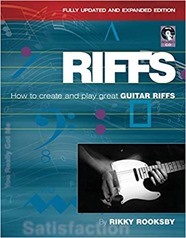 Another guitar book in this review, I previously read How to write songs on Guitar by Rikky Rooksby, this book Riffs: How to Create and Play Great Guitar Riffs is by the same author.
Another guitar book in this review, I previously read How to write songs on Guitar by Rikky Rooksby, this book Riffs: How to Create and Play Great Guitar Riffs is by the same author.
A riff is a short musical phrase which is repeated throughout a track, it is common on guitar in rock music. It’s pretty easy to identify a riff in a rock song – which bit of "Smoke on the water" by Deep Purple do you think of when I mention it? "Back in black" by AC/DC? "Money" by Pink Floyd? That’s the riff. Later in the book Rooksby tells us that a riff can be as little as a bar long and 4 bars at an absolute maximum but it can be reinforced by repetition and variation. It’s surprising how few notes are required for a riff – two or three are sufficient at a push, five or six are plenty.
Riffs (the book) is structured into 6 sections, the first three sections cover riffs built on intervals, scales and chords respectively – there are roughly ten types of riff in each section. Section four covers playing and recording riffs, beyond the bare notes in the riff. Section five is a masterclass with John Paul Jones, of Led Zeppelin. The book finishes with a section which provides notes on the tracks on the accompanying CD which are illustrations of all the different types of riff with a few extras.
The first three sections running through the different types of riff features examples from "real" music to illustrate (and usually several examples per riff type). I really like these examples to refer to in discussions of music, I’m not at the point where I can read Rooksby’s commentary and understand what he means but the examples help make sense of the words. I found myself sitting with Spotify beside me as I read playing examples as they were mentioned.
It becomes clear looking at the examples which types of riff are the important ones – they feature the most well-known examples. For example, the mixolydian scale riffs include "I can’t get no satisfaction" by the Rolling Stones, and the chord version of this scale include "Louie Louie" by The Kingsmen and "Won’t get fooled again" by the Rolling Stones.
Rooksby comments that it isn’t entirely clear what is a chord progression and what is a chord riff – he differentiates in terms of speed and distinctive rhythm – riffs are faster.
Guitar tabs are not provided for the examples, I suspect this is largely for copyright reasons. The book contains references to several hundred tracks – I don’t like to think about the amount effort required to collect permission for all of the guitar tabs for the key riffs!
The techniques section talks a bit about the process of composition – recommending a drum track to assist the process. One of the key insights in the book is how key the rhythm is to a recognisable riff. He also talks in this section about how riffs are arranged both in terms of what the bass and drums are doing with the riff and also how the riff is created potentially with multiple guitars configured differently to "thicken" the sound.
I’m ambivalent about masterclass with John Paul Jones, it read like a high level technical discussion which went over my head but it was interesting to see where riffs come from "from the horses mouth".
The accompanying CD contains 56 tracks, almost all under a minute long and most of much less than that. The first 16 tracks fit in with a more tutorial introduction. The core 30 tracks illustrate the types of riff introduced in sections 1 to 3. Each track has the riff in standard musical notation and guitar tab format. The tracks feature the riff with an accompanying drum and rhythm (chord progression) track. I really liked this section, it helped clarify what each of the riff types sounded like and how they were constructed. It was also rather nice to be able to follow along matching up the music to the tabs for short musical phrases.
Experienced musicians make much of the importance of ear training, normally bemoaning the fact they did not do more when they were learning. I think they forget how hard it is, ear training is a combination of listening and knowing what is likely to come next on the basis of musical theory (or a lot of experience). If you don’t have that implicit knowledge, ear training is really hard. This book is handy in providing musical context.
In common with How to write songs on Guitar, I really liked this book. Rooksby’s writing style is good, there is some music theory but what makes it great is putting that theory into context. My next task is to go through the riffs recorded on the CD with my guitar and the book and see if I can recreate them.

